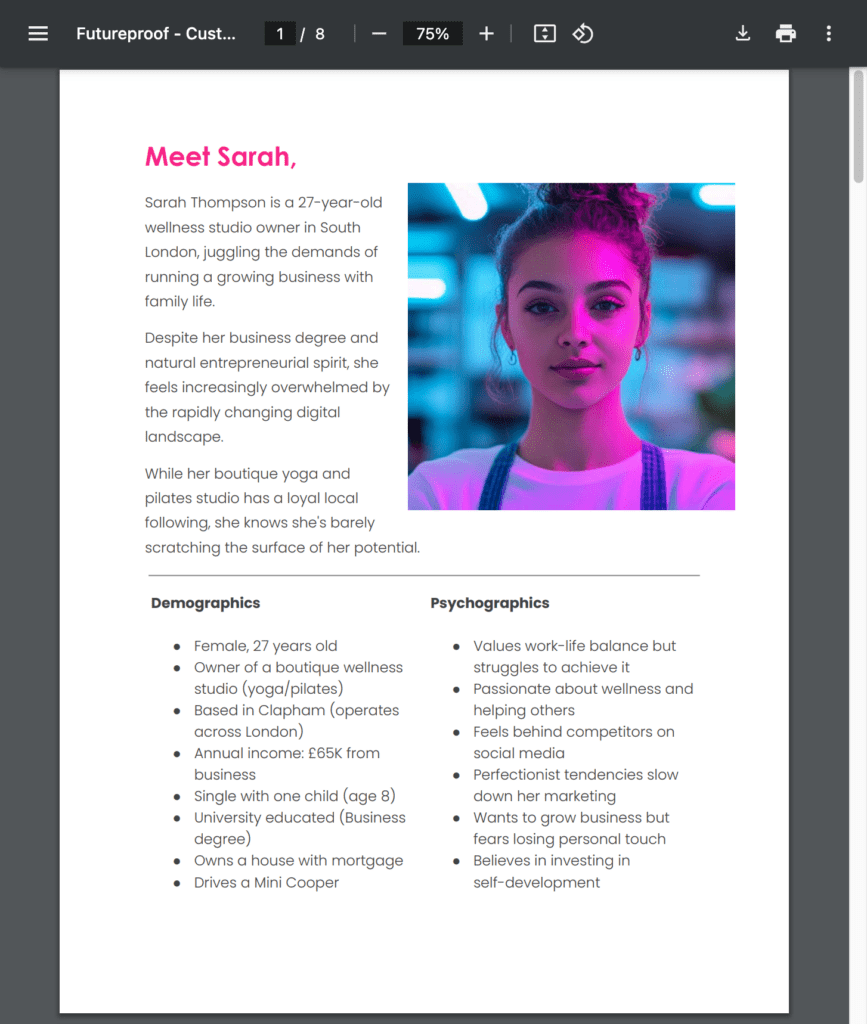Previous:
Next:
Why customer personas matter
Imagine trying to sell something without knowing who you’re speaking to, their needs, challenges, or even how they prefer to communicate. That’s what happens when businesses market without understanding their audience. This is where customer personas come in.
A customer persona is a detailed profile of your ideal customer, based on real data and insights. It’s not just a marketing tool; it’s a way to connect with your audience on a deeper level. Personas give your customers a face, a voice, and a story, helping you understand what truly motivates them.
Why does this matter? Because modern consumers expect tailored experiences and relevant solutions. Personas help you refine your marketing, align your products with customer needs, and strengthen relationships—leading to better results for your business.
Did you know:
Using marketing personas make websites 2-5 times more effective and easier to use by targeted users – HubSpot
What makes a good customer persona?
A strong customer persona captures the full picture of your ideal customer: who they are, why they make decisions, and how they behave. It blends demographics, psychographics, and behavioural insights to create a detailed and actionable profile.
Demographics
Demographics like age, location, income, and education lay the groundwork of your persona, offering a snapshot of your customer’s background.
Demographic data can include:
- Age
- Income
- Job Role/Title
- Industry
- Education Level
- Location
- Relationship Status
- Family Structure
- Housing Situation
- Employment Status
- Work Experience Level
- Company Size (where they work)
Psychographics
Psychographics go deeper, exploring values, goals, interests, and pain points. These insights reveal the “why” behind behaviour of what motivates them, what frustrates them, and what they truly care about.
Psychographic data can include:
Values & Beliefs
- Personal principles
- Political views
- Environmental stance
- Social causes
- Religious/spiritual beliefs
Lifestyle Choices
- Work-life balance preferences
- Health/wellness habits
- Social activities
- Hobbies/interests
- Entertainment choices
Personal Goals & Aspirations
- Career ambitions
- Personal development goals
- Lifestyle aspirations
- Financial objectives
- Family/relationship goals
Pain Points & Challenges
- Daily frustrations
- Career challenges
- Personal struggles
- Time constraints
- Financial concerns
Motivations
- Career drivers
- Personal motivators
- Purchase triggers
- Learning motivations
- Social drivers
Decision-Making Factors
- Research habits
- Trust factors
- Price sensitivity
- Brand loyalty
- Quality vs convenience preferences
Learning Style
- Information consumption preferences
- Content format preferences
- Self-education habits
- Professional development approach
- Technology adoption speed
Personality Traits
- Communication style
- Risk tolerance
- Social preferences (introvert/extrovert)
- Leadership style
- Change adaptability
Behavioural profiling
This focuses on what your audience does, such as purchase history, browsing habits, or engagement patterns. Do they frequently buy from you or just browse? Do they engage with emails or prefer social media? These insights help predict future actions and refine your approach.
Behavioural data can include:
Purchase Behaviour
- Frequency of purchases
- Average spend amount
- Purchase decision timing
- Preferred payment methods
- Brand switching patterns
- Seasonal buying habits
- Impulse vs planned buying
Online Activity
- Device preferences
- Browsing patterns
- Social media engagement
- Content consumption times
- Email interaction habits
- App usage patterns
- Search behavior
Research & Decision Process
- Information sources used
- Research depth
- Review reading habits
- Comparison shopping behavior
- Free trial/demo usage
- Consultation preferences
- Decision timeline
Engagement Patterns
- Content interaction style
- Response to marketing
- Customer service usage
- Feedback giving habits
- Community participation
- Loyalty program usage
- Referral behavior
Problem-Solving Approach
- Self-service vs support seeking
- Troubleshooting methods
- Learning style in practice
- Help resource preferences
- Question-asking patterns
- Follow-up behavior
Usage Patterns
- Time of day activity
- Frequency of use
- Feature adoption
- Customization preferences
- Integration with other tools
- Upgrade/downgrade patterns
- Abandonment triggers
The most effective personas are specific and tell a clear story. For example, instead of “Young Professionals,” think “Emma, a 30 year old marketing manager who values efficiency, shops online during lunch breaks, and prefers chat support.”
The process of creating a customer persona
Creating a customer persona is a step-by-step process that turns raw data into a vivid, practical profile of your ideal customer.
Gather data
Start by collecting insights from multiple sources:
- Analyse your existing customer base
- Conduct customer surveys and interviews for first-hand feedback.
- Analyse website analytics to identify audience demographics and behaviour.
- Use social media insights to understand interests and engagement.
- Gather input from sales or customer service teams who interact directly with customers.
Using artificial intelligence
If you have a new business or just starting out, you may not have access to customer data and analytics. In this case, you can use an AI platform like ChatGPT to provide sample data. For example, if you are thinking of opening a nail salon, you may want to ask:
- What audiences would be interested in a nail salon?
- What goals do they have?
- What pain points and challenges do they face?
- What are their typical buying patterns?
- What social media do they prefer?
Asking questions like this will provide you with data that is common in most scenarios, however, for real accuracy you can’t beat real world data.
Identify patterns
When you have gathered your data, you can now analyse it to uncover common traits. Look for recurring goals, challenges, behaviours, or preferences. These patterns help group your audience into clear, distinct segments.
Build the persona
- Give your persona a name, a photo, and a brief backstory.
- Include key details: demographics, values, pain points, goals, and buying behaviours.
- Focus on specifics: Instead of “Young professionals,” say “Sarah, a 27-year-old wellness studio owner in South London, juggling the demands of running a growing business with family life.”

AI platforms like ChatGPT and Claude are great for speeding up the process of creating customer personas. You can input all of the data gathered, and request customer personas based on your data. You can also request patterns and trends to gain additional insights. However, with large language models such as ChatGPT, always ensure you check the information, because they can be prone to errors and misinformation.
Validate and refine
Test your personas against real customer feedback and adjust them over time. Businesses change, and so do their audiences.
Putting personas into practice
Creating customer personas is just the beginning. The real value lies in how you use them to shape your strategy and decision making. Personas act as a guide, ensuring every aspect of your business is aligned with the needs and preferences of your audience.
Customer personas can help you craft targeted campaigns with messages that resonate. Instead of a one size fits all approach, you can tailor content, tone, and channels to match how each persona prefers to engage.
For example, a time poor professional might appreciate concise, actionable emails, while a detail oriented customer may prefer in depth guides or case studies.
Creating personas in digital marketing can have a significant impact on the effectiveness of your campaigns. Here are some evidence based statistics:
1. Increased Website Effectiveness: According to HubSpot, using personas can make websites two to five times more effective.
2. Higher Email Open Rates: Marketing campaigns that utilise personas can see email open rates increase by up to 22%.
3. Improved Conversion Rates: Personalised marketing strategies, which often stem from well crafted personas, can lead to higher conversion rates. A study by McKinsey found that 71% of consumers expect personalised interactions, and companies that meet this expectation see
4. Better Customer Engagement: Personas help in creating content that resonates with your audience, leading to better engagement. For instance, personalised content can increase click-through rates by up to 14%.
These statistics highlight the importance of understanding your audience deeply and crafting your marketing efforts around those insights.
Product development
By understanding customer pain points and goals, you can create solutions that genuinely solve their problems.
Customer service
Knowing how a persona feels and communicates allows you to personalise support and build stronger relationships.
In practice, personas become a filter for decisions. Whether designing a website, launching an ad campaign, or refining a product, you can ask, “Does this meet the needs of this persona?” This approach ensures you’re not just creating for the sake of it you’re creating with purpose.
Avoiding common mistakes
While customer personas are powerful tools, they can lose their impact if common mistakes creep in. Avoid these pitfalls:
Relying on assumptions
Personas built on assumptions risk being inaccurate. Always use real data from surveys, interviews, analytics, or social media.
Being too broad
Vague personas like “Millennials” or “Busy Professionals” don’t offer enough insight to guide strategy. Focus on specific traits, challenges, and goals.
Creating too many personas
Too many profiles can dilute focus. Stick to a manageable number that represents your key customer groups.
Letting personas become static
Audiences change over time, and your personas need to evolve with them. Regularly revisit and refine them based on fresh data.
AI and modern persona development
Artificial intelligence is transforming customer personas into dynamic, data-driven insights, ensuring they evolve in real time. Here’s how AI impacts persona creation and management:
Real-time evolution
AI can be used to update personas continuously, adapting to shifting customer behaviours without waiting for periodic reviews. Examples of this include Segment by Twilio, which uses real-time data from various sources to dynamically update customer profiles. HubSpot CRM’ tracks real-time customer interactions across multiple channels and updates customer data dynamically for refined persona-based marketing. And Salesforce Einstein uses AI to provide continuous updates on customer insights based on real-time interactions.
Pattern recognition at scale
AI can uncover hidden insights by analysing vast data sources like website interactions, purchase behaviours, social media, and customer service logs. Software like Synerise AI Growth Cloud, can consolidate customer data from online and offline channels to monitor and analyse consumer experiences to uncover hidden patterns and predict customer behaviour. Similarly, Adobe Experience Cloud uses AI to analyse real-time data streams, enabling businesses to identify patterns in customer behaviour across various touch points.
Scalable personalisation
AI enables personalised experiences for thousands of users simultaneously, such as adjusting website content, customising email campaigns, and optimising touch points. For example, Optimizely’s Personalization platform uses AI to deliver real-time, scalable personalised experiences across digital touch points by analysing user behaviors and preferences. It integrates data from multiple sources, supports advanced testing, and offers user-friendly tools to optimize customer engagement and conversions.
Practical implementation
To maximise AI’s potential:
- Use AI tools for data collection and insights.
- Balance AI findings with human interpretation and strategy.
- Regularly validate AI-generated personas with real feedback to keep them accurate.
AI-driven personas combine the speed of technology with the nuance of human insight, ensuring relevance and deeper customer connections.
As businesses evolve, so too must their personas. Incorporating artificial intelligence ensures that your personas stay dynamic, relevant, and actionable. Whether you’re crafting a marketing campaign, designing a product, or improving customer interactions, well researched and continuously refined personas guide you toward decisions that not only meet customer needs but also build lasting relationships.
Remember: great personas are not static profiles. They are living insights, evolving with your customers and the market. By committing to this process, you’ll not only understand your audience, you’ll connect with them in meaningful, impactful ways.


















Leave a comment